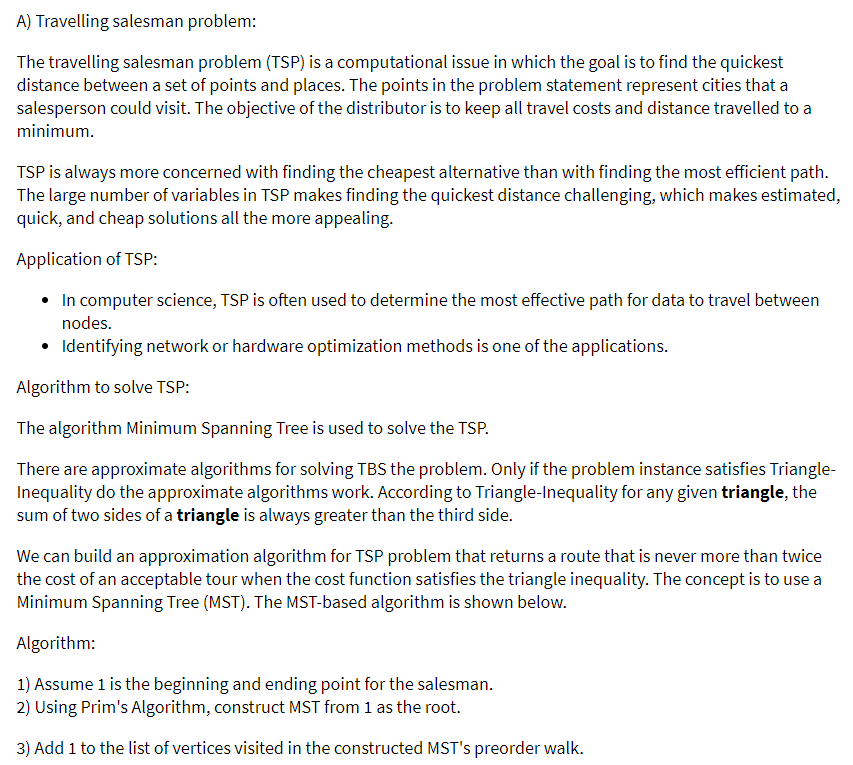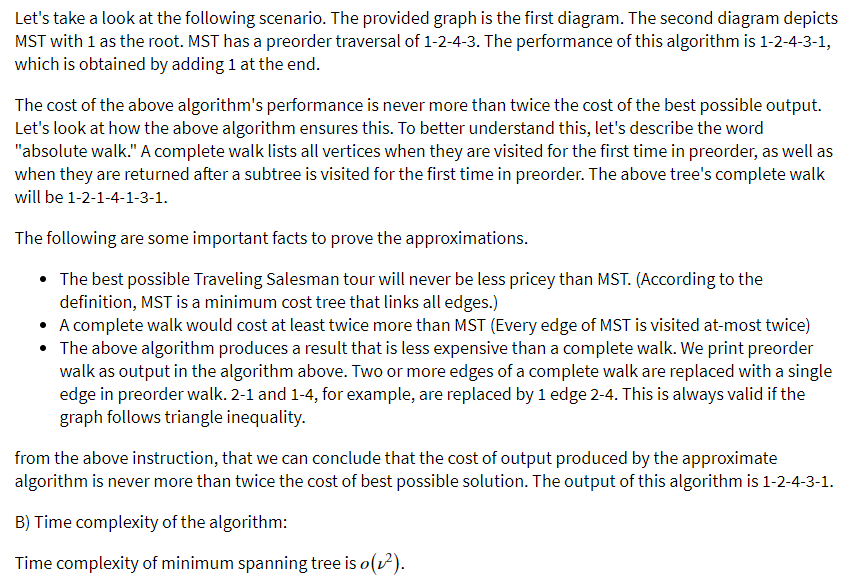This is an answer. Please summarize it
Operations Research : Applications and Algorithms
4th Edition
ISBN:9780534380588
Author:Wayne L. Winston
Publisher:Wayne L. Winston
Chapter18: Deterministic Dynamic Programming
Section: Chapter Questions
Problem 11RP
Related questions
Question
This is an answer. Please summarize it

Transcribed Image Text:A) Travelling salesman problem:
The travelling salesman problem (TSP) is a computational issue in which the goal is to find the quickest
distance between a set of points and places. The points in the problem statement represent cities that a
salesperson could visit. The objective of the distributor is to keep all travel costs and distance travelled to a
minimum.
TSP is always more concerned with finding the cheapest alternative than with finding the most efficient path.
The large number of variables in TSP makes finding the quickest distance challenging, which makes estimated,
quick, and cheap solutions all the more appealing.
Application of TSP:
In computer science, TSP is often used to determine the most effective path for data to travel between
nodes.
• Identifying network or hardware optimization methods is one of the applications.
Algorithm to solve TSP:
The algorithm Minimum Spanning Tree is used to solve the TSP.
There are approximate algorithms for solving TBS the problem. Only if the problem instance satisfies Triangle-
Inequality do the approximate algorithms work. According to Triangle-Inequality for any given triangle, the
sum of two sides of a triangle is always greater than the third side.
We can build an approximation algorithm for TSP problem that returns a route that is never more than twice
the cost of an acceptable tour when the cost function satisfies the triangle inequality. The concept is to use a
Minimum Spanning Tree (MST). The MST-based algorithm is shown below.
Algorithm:
1) Assume 1 is the beginning and ending point for the salesman.
2) Using Prim's Algorithm, construct MST from 1 as the root.
3) Add 1 to the list of vertices visited in the constructed MST's preorder walk.

Transcribed Image Text:Let's take a look at the following scenario. The provided graph is the first diagram. The second diagram depicts
MST with 1 as the root. MST has a preorder traversal of 1-2-4-3. The performance of this algorithm is 1-2-4-3-1,
which is obtained by adding 1 at the end.
The cost of the above algorithm's performance is never more than twice the cost of the best possible output.
Let's look at how the above algorithm ensures this. To better understand this, let's describe the word
"absolute walk." A complete walk lists all vertices when they are visited for the first time in preorder, as well as
when they are returned after a subtree is visited for the first time in preorder. The above tree's complete walk
will be 1-2-1-4-1-3-1.
The following are some important facts to prove the approximations.
The best possible Traveling Salesman tour will never be less pricey than MST. (According to the
definition, MST is a minimum cost tree that links all edges.)
• A complete walk would cost at least twice more than MST (Every edge of MST is visited at-most twice)
• The above algorithm produces a result that is less expensive than a complete walk. We print preorder
walk as output in the algorithm above. Two or more edges of a complete walk are replaced with a single
edge in preorder walk. 2-1 and 1-4, for example, are replaced by 1 edge 2-4. This is always valid if the
graph follows triangle inequality.
from the above instruction, that we can conclude that the cost of output produced by the approximate
algorithm is never more than twice the cost of best possible solution. The output of this algorithm is 1-2-4-3-1.
B) Time complexity of the algorithm:
Time complexity of minimum spanning tree is o(v).
Expert Solution
This question has been solved!
Explore an expertly crafted, step-by-step solution for a thorough understanding of key concepts.
Step by step
Solved in 3 steps with 2 images

Knowledge Booster
Learn more about
Need a deep-dive on the concept behind this application? Look no further. Learn more about this topic, computer-science and related others by exploring similar questions and additional content below.Recommended textbooks for you

Operations Research : Applications and Algorithms
Computer Science
ISBN:
9780534380588
Author:
Wayne L. Winston
Publisher:
Brooks Cole

Operations Research : Applications and Algorithms
Computer Science
ISBN:
9780534380588
Author:
Wayne L. Winston
Publisher:
Brooks Cole